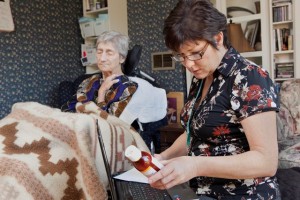A palliative patient at home. Most Canadians indicate that, if given the choice, they would choose to die at home with loved ones, yet almost 70 per cent of deaths occur in hospital. As well, there is an ongoing need for acute care beds in hospitals – in-home palliative care would save these beds for those who need it most while giving end-of-life patients a choice in where to spend their final days. We know that addressing how people age is of great importance, but we also need to shine a light on delivering end-of-life care that is both effective and supportive for our patients, their families, and their circle of care. In the past, here in Toronto, palliative care in the community
Category: hospitals
Dear CMS, price matters
Your government at work. Here’s the pertinent quote from Melinda Beck’s Wall Street Journal article on proton beam therapy:But some insurers are balking at paying premium rates for proton therapy for such common cancers without more evidence that it does improve patient outcomes—ideally from randomized controlled trials. Several are now under way, but it will be years before results are clear. Most Medicare regions cover proton therapy for prostate—at about $1,100 per treatment session, compared with $600 for IMRT. But several major insurers stopped after a 2012 study found it has no added long-term benefit. Men with prostate cancer had made up 70{c754d8f4a6af077a182a96e5a5e47e38ce50ff83c235579d09299c097124e52d} of patients at some proton centers; now they are less than half the facilities’ customers nationwide. It’s time for the government to have
Lean double header all-star session
Each summer, I particpate as a faculty member in an executive education short program at MIT called “Technology, Organizations, and Innovation: Putting Ideas to Work.” We spend several engaging days with students from around the world. They represent a wide range of industries.From the course summary:Innovation typically begins with a new technical concept or other bright idea. But the idea is just the first step on the long path to successful innovation. Technical change usually requires organizational changes as well. These changes include providing resources for technical development and acquiring the support of others in the organization or in outside organizations. Gaining this support requires negotiation, bargaining, and coalition building. Organizational change, then, is a very complex process. Change of this sort can be
Captivated by captives
One of the educational benefits of being CEO of one of the Harvard-affiliated teaching hospitals was that I also served on the board of our captive insurance company, CRICO, and its subsidiary, the Risk Management Foundation. Like many people, I had not previously understood the ins and outs of risk retention groups, medical malpractice insurance, and risk management, and so this was a great experience.As noted on its website:In 1976, the crisis of insurance availability led the Harvard Medical Institutions to form a “captive” medical professional liability insurer, CRICO, an offshore insurance company operating and domiciled in the Cayman Islands. Harvard’s model of creating an offshore captive—an insurer owned by the facility or health care system it exclusively insures—was later replicated by other health systems
The Triple Aimers have missed the mark
This is one of those columns that will risk the respect and friendship of some of my closest colleagues in the health care world. In addition to disagreeing with me, they may argue that I am giving aid and ammunition to “the enemy,” where the enemy might be viewed as those forces in the health care world who really don’t want things to change. But as you shall see, I will assert that it is those very colleagues who–by focusing on an overly simplistic ideological approach to health care policy–are inadvertently giving succor to that same group by providing political cover for nefarious behavior.I refer to many of the most prominent advocates of the Triple Aim.As set forth in this article and
Review: ‘The Digital Doctor’ by Robert Wachter Weighs Medicine’s Technological Transformation
The author is both doubtful and hopeful, old enough to remember the way things used to work, young enough to appreciate technology.
Obamacare’s Big Gamble on Hospital Productivity
An influential theory says productivity growth in health care is inherently low, but a new study offers reason for hope.
: Providing methods to help children with chronic pain
For many of us, describing physical pain can be as simple as saying “ouch” when we stub our toe. But as a clinician, what happens when your client can’t clearly communicate how much pain they are in? This situation is common for many clinicians at Holland Bloorview Kids Rehabilitation Hospital who often meet children who have difficulty communicating the kinds of physical pain they feel due to a disability or medical condition. Children with cerebral palsy (CP) experience multiple sites and sources of ongoing pain due to changes in the body as a result of CP. In many cases, acute and procedural pain is recognizable to a clinician or parent, whereas chronic pain is more likely to be missed. In fact, a Holland Bloorview study showed that 25
Wide Use of Antibiotics Allows C. Diff to Flourish
Hospitals have reported drastic increases in severe cases of C. difficile, but new treatments offer hope.
Dog-bite study shows familiarity with dog may bring false sense of security
Prior studies have shown that most dog-bite injuries result from family dogs. A new study conducted by Mayo Clinic and Phoenix Children’s Hospital shed some further light on the nature of these injuries.
Colorado: Veterans Hospital Construction Resumes
Construction crews returned to work Friday after the United States Senate approved a last-minute deal to avoid a construction shutdown at a troubled veterans’ hospital outside Denver.







